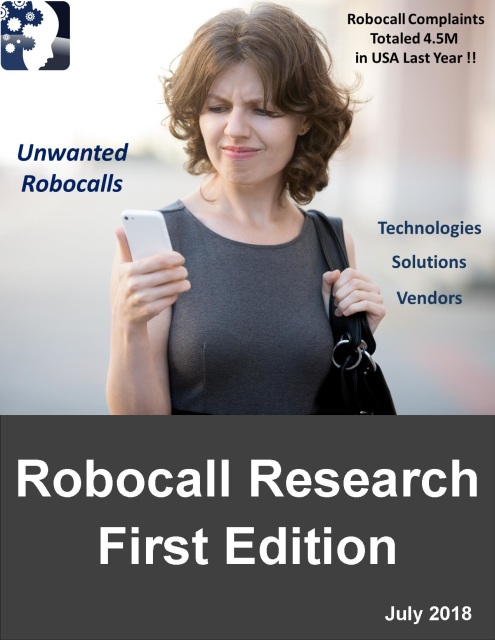Title: Robocall Detection and Unwanted Call Management: RoboResearch, First Edition
Published: July 2018
Pricing by License: $ 3,995 USD
Overview:
Commonly referred to as robocalls, computer-generated phone calls are used by legitimate organizations such as schools, churches, and public safety agencies to place calls to registered constituents. Public safety agencies will make reverse 9-1-1 robocalls in the event of a natural disaster or some catastrophe such as a train derailment. However, some Bad Actors use robocalling to trick or even defraud consumers in a random manner. According to YouMail, Americans received over 4 billion such calls in June 2018 alone.
The typical scenario involves a Bad Actor calling a consumer with some type of story about a special offer or concern that the called party is compelled to act upon immediately. In these instances, the calling party is seeking to either extort money directly or obtain identity information (such as credit card info) necessary to steal from the consumer. Technology tricks are used to gain the trust of the consumer such as local number spoofing, which is a technique that involves manipulating the calling party’s number to appear different than the actual number.
Mind Commerce has coined the term “Problematic” to refer to any telephone number that that is identified as a cause for concern including spam, abusive telemarketer or debt collector, scam or fraud. Leading Robocall Detection and Unwanted Call Management solutions use various technologies such as advanced data analytics and artificial intelligence to determine if a number is problematic, and if so, the degree of concern (e.g. Spam, Scam, or Fraud).
Robocall Research, First Edition evaluates the current state of automated calling (robocalls), technologies for dealing with unwanted calls, leading companies and solutions. This report also analyzes industry challenges and the future outlook for robocall technologies and solutions to defeat spammers, scammers, and fraudsters. It also provides a look into the future of robocall detection including evolution of telecom data analytics, network-based authentication (such as STIR/SHAKEN) and network-based intelligence (such as call origination identification).
Who Will Benefit from this Report?
Table of Contents:
3.1.2.Who are the Bad Actors?
3.1.3.Bad Actor Practices
3.2.2.Who are the Good Actors?
3.2.3.When Legal and Ethical Lines are Crossed
4.1.2.Identification and Verification Methods
4.2.2.Advantages and Disadvantages
4.3.2.Call Volume
4.3.3.Behavior Changes
4.4.2.Call Path
4.4.3.Call Termination
4.5.2.STIR/SHAKEN
5.1.2.The Gray Market
5.1.3.The Black Market
5.2.2.Unwanted Call Management
5.3.2.Verified Business
6.3.2.False Negatives
6.5.2.My Calls are Always Legitimate: “White List My Business”
7.3.2.Conformance among Leading Solutions
7.3.3.Accuracy among Leading Solutions
7.3.4.Needed Areas of Improvement
7.3.5.The Need for Periodic Testing
8.4.2.Data Privacy and the Need for Encrypted Data
Published: July 2018
Pricing by License: $ 3,995 USD
Overview:
Commonly referred to as robocalls, computer-generated phone calls are used by legitimate organizations such as schools, churches, and public safety agencies to place calls to registered constituents. Public safety agencies will make reverse 9-1-1 robocalls in the event of a natural disaster or some catastrophe such as a train derailment. However, some Bad Actors use robocalling to trick or even defraud consumers in a random manner. According to YouMail, Americans received over 4 billion such calls in June 2018 alone.
The typical scenario involves a Bad Actor calling a consumer with some type of story about a special offer or concern that the called party is compelled to act upon immediately. In these instances, the calling party is seeking to either extort money directly or obtain identity information (such as credit card info) necessary to steal from the consumer. Technology tricks are used to gain the trust of the consumer such as local number spoofing, which is a technique that involves manipulating the calling party’s number to appear different than the actual number.
Mind Commerce has coined the term “Problematic” to refer to any telephone number that that is identified as a cause for concern including spam, abusive telemarketer or debt collector, scam or fraud. Leading Robocall Detection and Unwanted Call Management solutions use various technologies such as advanced data analytics and artificial intelligence to determine if a number is problematic, and if so, the degree of concern (e.g. Spam, Scam, or Fraud).
Robocall Research, First Edition evaluates the current state of automated calling (robocalls), technologies for dealing with unwanted calls, leading companies and solutions. This report also analyzes industry challenges and the future outlook for robocall technologies and solutions to defeat spammers, scammers, and fraudsters. It also provides a look into the future of robocall detection including evolution of telecom data analytics, network-based authentication (such as STIR/SHAKEN) and network-based intelligence (such as call origination identification).
- Vendor solutions covered in this report include: First Orion, Hiya, and TNS
- Carrier solutions covered in this report include: AT&T Wireless’s “Call Protect”, T-Mobile’s “SCAM ID in combination with Name ID”, Verizon Wireless’s “Enhanced Caller Name ID
Who Will Benefit from this Report?
- Robocall Solution Providers
- Communications Service Providers
- Software and Application Developers
- Telecommunications Infrastructure Providers
Table of Contents:
- Introduction
- What is a Robocall?
- Current State of the Problem
- About the First Edition of Robocall Research
- How Robocalls Work
- Architecture
- Technologies
- Who Uses Robocalling
- The Illegal, Unethical Minority
3.1.2.Who are the Bad Actors?
3.1.3.Bad Actor Practices
- Misrepresentation
- Number Spoofing
- The Legal and Legitimate Majority
3.2.2.Who are the Good Actors?
3.2.3.When Legal and Ethical Lines are Crossed
- Detection and Management Approaches
- Method Types
4.1.2.Identification and Verification Methods
- Crowd Sourcing
4.2.2.Advantages and Disadvantages
- Data Analytics
4.3.2.Call Volume
4.3.3.Behavior Changes
- Network Diagnostics
4.4.2.Call Path
4.4.3.Call Termination
- Future Technologies
4.5.2.STIR/SHAKEN
- The Market
- The Good, the Bad, and the Ugly
5.1.2.The Gray Market
5.1.3.The Black Market
- Consumer Market
5.2.2.Unwanted Call Management
- Business Market
5.3.2.Verified Business
- Industry Challenges
- Awareness of Issues: Solution Availability and Usage
- The Backlash of Neighborhood Spoofing
- When Solutions Getting it Right and Get it Wrong
6.3.2.False Negatives
- Consumer Issues
- Annoyance vs. Real Risks
- Actual Personal and Financial Risks
- Who has Control of your Private Data?
- Who knows your Call Habits?
- Business Backlash
6.5.2.My Calls are Always Legitimate: “White List My Business”
- Solution Provider Analysis
- What Characterizes a Market Leader
- The Long Tail of Solution Providers
- What our Latest Testing Indicates
7.3.2.Conformance among Leading Solutions
7.3.3.Accuracy among Leading Solutions
7.3.4.Needed Areas of Improvement
7.3.5.The Need for Periodic Testing
- The Future Outlook
- Regulatory Actions
- Technology Advancements
- Continuous Solution Improvements
- Mind Commerce Point of View Areas
8.4.2.Data Privacy and the Need for Encrypted Data

